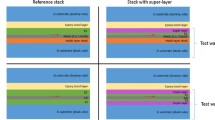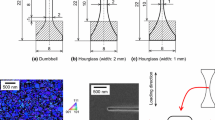Abstract
In devices that integrate dissimilar materials in small dimensions, crack extension in one material often accompanies inelastic deformation in another. In this paper we analyze a channel crack advancing in an elastic film, while an underlayer creeps. The film is subject to a tensile stress. As the underlayer creeps, the stress field in the film relaxes in the crack wake, and intensifies around the crack tip. In a blanket film, the crack can attain a steady velocity, set by two rate processes: subcritical decohesion at the crack tip, and creep in the underlayer. In a thin-film microbridge over a viscous stripe, the crack cannot grow when the bridge is short, and can grow at a steady velocity when the bridge is long. We use a two-dimensional shear lag model to approximate the three-dimensional fracture process, and an extended finite element method to simulate the moving crack with an invariant, relatively coarse mesh. On the basis of the theoretical findings, we propose new experiments to measure fracture toughness and creep laws in small structures. As a byproduct, an analytical formula is found for the growth rate per temperature cycle of a channel crack in a brittle film, induced by ratcheting plastic deformation in a metal underlayer.
Similar content being viewed by others
References
M.D. Thouless, “Cracking and Delamination of Coatings,”J. Vac. Sci. Technol. A,9,2510–2515 (1991).
Hutchinson, J.W. andSuo, Z., “Mixed-mode Cracking in Layered Materials,”Advances in Applied Mechanics,29,63–191 (1992).
Evans, A.G. andHutchinson, J.W., “The Thermomechanical Integrity of Thin Films and Multilayers,”Acta Metall. Mater.,43,2507–2530 (1995).
Cook, R.F. andSuo, Z., “Mechanisms Active during Fracture under Constraint,”MRS Bulletin,27,45–51 (2002).
Suo, Z., “Reliability of Interconnect Structures.” A Manuscript prepared as a chapter in Volume 8: Interfacial and Nanoscale Failure, W. Gerberich and W. Yang, eds., Comprehensive Structural Integrity, I. Milne, R.O. Ritchie, and B. Karihaloo, editors-in-Chief. Due for publication early 2003. (Preprint available online at http://www.princeton.edu/∼suo, Publication 139.)
Kook, S.-Y. andDauskardt, R.H., “Moisture-assisted Subcritical Debonding of a Polymer/Metal Interface,”J. Appl. Phys.,91,1293–1303 (2002).
Soboyejo, W.O., Wang, R., Katsube, N., Seghi, R., Pagedas, C., Skraba, P., Mumm, D.R., andEvans, A.G., “Contact Damage of Model Dental Multilayers: Experiments and Finite Element Simulations,”Key Engineering Materials,198–199,135–178 (2001).
Kahn, H., Heuer, A.H., andBallarini, R., “On-chip Testing of Mechanical Properties of MEMS Devices,”MRS Bulletin,26,300–301 (2001).
Muhlstein, C.L., Stach, E.A., andRitchie, R.O., “Mechanism of Fatigue in Micron-scale Films of Polycrystalline Silicon for Microelectromechanical Systems,”Appl. Phys. Lett.,80,1532–1534 (2002).
Evans, A.G., Mumm, D.R., Hutchinson, J.W., Meier, G.H., andPettit, F.S., “Mechanisms Controlling the Durability of Thermal Barrier Coatings,”Progress in Materials Science,46,505–553 (2001).
Huang, M., Suo, Z., Ma, Q., andFujimoto, H., “Thin Film Cracking and Ratcheting Caused by Temperature Cycling,”J. Mater. Res.,15,1239–1242 (2000).
Huang, M., Suo, Z., andMa, Q., “Plastic Ratcheting Induced Cracks in Thin Film Structures,”J. Mech. Phys. Solids,50,1079–1098 (2002).
Begley, M.R. andEvans, A.G., “Progressive Cracking of a Multilayer System upon Thermal Cycling,”J. Appl. Mech.,68,513–520 (2001).
He, M.Y., Evans, A.G., andHutchinson, J.W., “The Ratcheting of Compressed Thermally Grown Thin Films on Ductile Substrates,”Acta Mater.,48,2593–2601 (2000).
Karlsson, A.M. andEvans, A.G., “A Numerical Model for the Cyclic Instability of Thermally Grown Oxides in Thermal Barrier Systems,”Acta Mater.,49,1793–1804 (2001).
Beuth, J.L., “Cracking of Thin Bonded Films in Residual Tension,”Int. J. Solids Structures,29,1657–1675 (1992).
Ye, T., Suo, Z., andEvans, A.G., “Thin Film Cracking and the Roles of Substrate and Interface,”Int. J. Solids Structures,29,2639–2648 (1992).
Hu, M.S. andEvans, A.G., “The Cracking and Decohesion of Thin Films on Ductile Substrates,”Acta Metall.,37,917–925 (1989).
Beuth, J.L. andKlingbeil, N.W., “Cracking of Thin Films Bonded to Elastic-plastic Substrates,”J. Mech. Phys. Solids,44,1411–1428 (1996).
Leterrier, Y., Boogh, L., Andersons, J. andMansons, J-A. E., “Adhesion of Silicon Oxide Layers on Poly(ethylene-terephthalate) I: Effect of Substrate Properties on Coatings Fragmentation Process,”J. Polym. Sci. Part B. Polm. Phys.,35,1449–1461 (1997).
Hobart, K.D., Kub, F.J., Fatemi, M., Twigg, M.E., Thompson, P.E., Kuan, T.S., andInoki, C.K., “Compliant Substrates: A Comprehensive Study of the Relaxation Mechanisms of Strained Films Bonded to High and Low Viscosity Oxides,”J. Electron. Mater.,29,897–900 (2000).
Yin, H., Huang, R., Hobart, K.D., Suo, Z., Kuan, T.S., Inoki, C.K., Shieh, S.R., Duffy, T.S., Kub, F.J., andSturm, J.C., “Strain Relaxation of SiGe Islands on Compliant Oxide,”J. Appl. Phys.,91,9716–9722 (2002).
Wagner, H.S., Gleskova, H., Sturm, J.C., andSuo, Z., “Novel Processing Technology for Macroelectronics,”in Technology and Applications of Amorphous Silicon, R.A. Street, ed., pp.222–251, Springer, Berlin (2000).
Sikder, A.K., Irfan, I.M., Kumar, A., andAnthony, J.M., “Nano-Indentation Studies of Xerogel and Silk Low-k Dielectric Materials,”J. Electron. Mater.,30,1527–1531 (2001).
Toivola, Y., Thurn, J., Cook, R.F., “Structural, Electrical, and Mechanical Properties Development During Curing Of Low-k Hydrogen Silsesquioxane Films,”J. Electrochem. Soc.,149,F9-F17 (2002).
Huang, R., Prévost, J.H., andSuo, Z., “Loss of Constraint on Fracture in Thin Film Structures Due to Creep,”Acta Mater.,50,4137–4148 (2002).
Freund, L.B. and Nix, W.D., unpublished work.
Moran, P.D. andKuech, T.F., “Kinetics of Strain Relaxation in Semiconductor Films Grown on Borosilicate Glass-bonded Substrates,”J. Electron. Mater.,30,802–806 (2001).
Huang, R., Yin, H., Liang, J., Hobart, K.D., Sturm, J.C., andSuo, Z., “Relaxation of a Strained Elastic Island on a Viscous Layer,”Mater. Res. Soc. Symp. Proc.,695,115–120 (2001).
Dmowska, R. andRice, J.R., “Fracture Theory and Its Seismological Applications,”in Continuum Theories in Solid Earth Physics, R. Teisseyre, ed., Physics and Evolution of the Earth's Interiol, Vol. 3, pp.187–255, Elsevier, Oxford (1986).
Freund, L.B., Dynamic Fracture Mechanics, Cambridge University Press (1990).
Nix, W.D., “Mechanical Properties of Thin Films,”Metall. Trans. A,20,2217–2245 (1989).
Baker, S.P., Kretschmann, A., andArzt, E., “Thermomechanical Behavior of Different Texture Components in Cu Thin Films,”Acta Mater.,49,2145–2160 (2001).
Belytschko, T. andBlack T., “Elastic Crack Growth in Finite Elements with Minimal Remeshing,”Int. J. Numer. Methods Eng.,45,601–620 (1999).
Moës, N., Dolbow, J., andBelytschko, T., “A Finite Element Method for Crack Growth without Remeshing,”Int. J. Numer. Methods Eng.,46,131–150 (1999).
Daux, C., Moës, N., Dolbow, J., Sukumar, N., andBelytschko, T., “Arbitrary Branched and Intersecting Cracks with the Extended Finite Element Method,”Int. J. Numer. Methods Eng.,48,1741–1760 (2000).
Sukumar, N., Srolovitz, D.J., Baker, T.J., and Prévost, J.H., “Brittle Fracture in Polycrystalline Microstructures with the Extended Finite Element Method,” Int. J. Numer. Methods Eng., in press.
Prévost, J.H., “DYNAFLOW: A Nonlinear Transient Finite Element Analysis Program,” Princeton University (1981). Last updated in 2002.
Rice, J.R., “A Path Independent Integral and Approximate Analysis of Strain Concentration by Notches and Cracks,”J. Appl. Mech.,35,379–386 (1968).
Irwin, G. R., “Analysis of Stresses and Strains Near the End of a Crack Traversing a Plate,”J. Appl. Mech.,24,361–364 (1957).
Huang, H.B. andSpaepen, F., “Tensile Testing of Free-standing Cu, Ag and Al Thin Films and Ag/Cu Multilayers,”Acta Mater.,48,3261–3269 (2000).
LaVan D.A., Sharpe, W.N., “Tensile Testing of Microsamples,” EXPERIMENTAL MECHANICS,39,210–216 (1999).
Kraft, O. andVolkert, C.A., “Mechanical Testing of Thin Films and Small Structures,”Adv. Eng. Mater.,3 (3),99–110 (2001).
Vinci, R.P., Baker, S.P., eds., “Mechanical Properties in Small Dimensions,” MRS Bulletin,27,12–53 (2002).
Ma, Q., Xie, J., Chao, S., El-Mansy, S., McFadden, R., andFujimoto, H., “Channel Cracking Technique for Toughness Measurement of Brittle Dielectric Thin Films on Silicon Substrates,”Mater. Res. Soc. Symp. Proc. 516,331–336 (1998).
Lawn, B., Fracture of Brittle Solids, 2nd edition, Cambridge University Press (1993).
Suresh, S., Fatigue of Materials, 2nd edition, Cambridge University Press (1998).
Lehner, F.K., Li, V.C., andRice, J.R., “Stress Diffusion Along Rupture Plate Boundaries,”Journal of Geophysical Research,86,6155–6169 (1981).
Author information
Authors and Affiliations
Rights and permissions
About this article
Cite this article
Liang, J., Huang, R., Prévost, J.H. et al. Thin film cracking modulated by underlayer creep. Experimental Mechanics 43, 269–279 (2003). https://doi.org/10.1007/BF02410525
Received:
Revised:
Issue Date:
DOI: https://doi.org/10.1007/BF02410525




